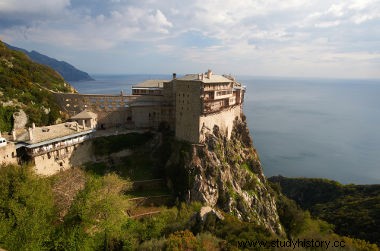
By Me. Cláudio Fernandes
Between the call Antique Late and the High Age Average , that is, around the 5th and 6th centuries AD, Christianity sought to stand out and establish itself as a religious institution in the midst of the crises triggered by the barbarian invasions, which devastated the Roman Empire. As a religion of universal character, Christianity managed to bring together individuals from the most diverse regions of the world, from Asia Minor to northern Europe. In addition to the organizations in bishoprics and the centrality of religious authority in the figure of the pope, other ways of living the Christian experience became fundamental. The life monastic and the construction of the monasteries were one of those ways of living.
More than a simple religious life, monastic life was characterized by seclusion and asceticism, that is, by the option of a life isolated from the common life with other people, who do not other monks, and subjected to austerity and discipline (which configures asceticism). The great symbol of monastic life that became the model for all later generations of monks was Saint Anthony of the Desert (or Saint Anthony of Egypt , as he was also known), who lived between the 3rd and 4th centuries A.D.
The first Christian monks, like Antão, were hermits or anchorites. This means that they withdrew from social interaction and went to completely unpopulated places, such as deserts, to live alone. Then, towards the end of the 6th century, there was the development of the system cenobitic . The cenobite monasticism, unlike the anchorite, was characterized by life in a cenobium, that is, in community. It was the Cenobite monks who started to build the monasteries in the early Middle Ages.
Medieval monasteries, whether Catholic or Orthodox, were built in places far away from any urban centers that had a large flow of people. A notorious example is the monastery of Simonos Petras , in Greece, built on top of a cliff, on Mount Athos (see image at top of text ). Life in the monasteries was, in addition to being dedicated to prayers, meditation, corporal discipline, etc., was also marked by the division of daily tasks, such as work in the fields, work in the kitchen, cleaning the monastery’s premises, among others. .
One of the people responsible for formulating norms for life in the monastery was Benedict of Núrsia (Italy). His set of rules became known as St. Benedict's Rule . In his “Rule”, Saint Benedict explained, item by item, how the behavior of monks should be, the right way and the right times to pray, how to handle and store the instruments used in farming, among other things.
The model of monastic life had a great impact in the Middle Ages, mainly because it presented itself as a civilizing and moralizing model. Likewise, monasteries became icons of the Middle Ages, as did universities, which also developed in the same period.
